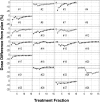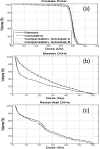Evaluations of an adaptive planning technique incorporating dose feedback in image-guided radiotherapy of prostate cancer
- PMID: 22149819
- PMCID: PMC3230638
- DOI: 10.1118/1.3658567
Evaluations of an adaptive planning technique incorporating dose feedback in image-guided radiotherapy of prostate cancer
Abstract
Purpose: Online image guidance (IG) has been used to effectively correct the setup error and inter-fraction rigid organ motion for prostate cancer. However, planning margins are still necessary to account for uncertainties such as deformation and intra-fraction motion. The purpose of this study is to investigate the effectiveness of an adaptive planning technique incorporating offline dose feedback to manage inter-fraction motion and residuals from online correction.
Methods: Repeated helical CT scans from 28 patients were included in the study. The contours of prostate and organs-at-risk (OARs) were delineated on each CT, and online IG was simulated by matching center-of-mass of prostate between treatment CTs and planning CT. A seven beam intensity modulated radiation therapy (IMRT) plan was designed for each patient on planning CT for a total of 15 fractions. Dose distribution at each fraction was evaluated based on actual contours of the target and OARs from that fraction. Cumulative dose up to each fraction was calculated by tracking each voxel based on a deformable registration algorithm. The cumulative dose was compared with the dose from initial plan. If the deviation exceeded the pre-defined threshold, such as 2% of the D₉₉ to the prostate, an adaptive planning technique called dose compensation was invoked, in which the cumulative dose distribution was fed back to the treatment planning system and the dose deficit was made up through boost radiation in future treatment fractions. The dose compensation was achieved by IMRT inverse planning. Two weekly compensation delivery strategies were simulated: one intended to deliver the boost dose in all future fractions (schedule A) and the other in the following week only (schedule B). The D₉₉ to prostate and generalized equivalent uniform dose (gEUD) to rectal wall and bladder were computed and compared with those without the dose compensation.
Results: If only 2% underdose is allowed at the end of the treatment course, then 11 patients fail. If the same criteria is assessed at the end of each week (every five fractions), then 14 patients fail, with three patients failing the 1st or 2nd week but passing at the end. The average dose deficit from these 14 patients was 4.4%. They improved to 2% after the weekly compensation. Out of these 14 patients who needed dose compensation, ten passed the dose criterion after weekly dose compensation, three patients failed marginally, and one patient still failed the criterion significantly (10% deficit), representing 3.6% of the patient population. A more aggressive compensation frequency (every three fractions) could successfully reduce the dose deficit to the acceptable level for this patient. The average number of required dose compensation re-planning per patient was 0.82 (0.79) per patient for schedule A (B) delivery strategy. The doses to OARs were not significantly different from the online IG only plans without dose compensation.
Conclusions: We have demonstrated the effectiveness of offline dose compensation technique in image-guided radiotherapy for prostate cancer. It can effectively account for residual uncertainties which cannot be corrected through online IG. Dose compensation allows further margin reduction and critical organs sparing.
Figures








Similar articles
-
Application of dose compensation in image-guided radiotherapy of prostate cancer.Phys Med Biol. 2006 Mar 21;51(6):1405-19. doi: 10.1088/0031-9155/51/6/003. Epub 2006 Feb 21. Phys Med Biol. 2006. PMID: 16510952
-
Online image-guided intensity-modulated radiotherapy for prostate cancer: How much improvement can we expect? A theoretical assessment of clinical benefits and potential dose escalation by improving precision and accuracy of radiation delivery.Int J Radiat Oncol Biol Phys. 2004 Dec 1;60(5):1602-10. doi: 10.1016/j.ijrobp.2004.07.709. Int J Radiat Oncol Biol Phys. 2004. PMID: 15590192
-
Dosimetric and geometric evaluation of a hybrid strategy of offline adaptive planning and online image guidance for prostate cancer radiotherapy.Phys Med Biol. 2011 Aug 7;56(15):5045-62. doi: 10.1088/0031-9155/56/15/024. Epub 2011 Jul 19. Phys Med Biol. 2011. PMID: 21772083 Free PMC article.
-
MRI-GUIDED RADIOTHERAPY FOR PROSTATE CANCER: A NEW PARADIGM.Acta Clin Croat. 2022 Oct;61(Suppl 3):65-70. doi: 10.20471/acc.2022.61.s3.9. Acta Clin Croat. 2022. PMID: 36938552 Free PMC article. Review.
-
Impact of technological advances in treatment planning, image guidance, and treatment delivery on target margin design for prostate cancer radiotherapy: an updated review.Br J Radiol. 2024 Jan 23;97(1153):31-40. doi: 10.1093/bjr/tqad041. Br J Radiol. 2024. PMID: 38263844 Free PMC article. Review.
Cited by
-
Validation of a dose warping algorithm using clinically realistic scenarios.Br J Radiol. 2015 May;88(1049):20140691. doi: 10.1259/bjr.20140691. Epub 2015 Mar 20. Br J Radiol. 2015. PMID: 25791569 Free PMC article.
-
Dose accumulation for MR-guided adaptive radiotherapy: From practical considerations to state-of-the-art clinical implementation.Front Oncol. 2023 Jan 26;12:1086258. doi: 10.3389/fonc.2022.1086258. eCollection 2022. Front Oncol. 2023. PMID: 36776378 Free PMC article. Review.
-
A framework for deformable image registration validation in radiotherapy clinical applications.J Appl Clin Med Phys. 2013 Jan 2;14(1):4066. doi: 10.1120/jacmp.v14i1.4066. J Appl Clin Med Phys. 2013. PMID: 23318394 Free PMC article.
-
Varian ethos online adaptive radiotherapy for prostate cancer: Early results of contouring accuracy, treatment plan quality, and treatment time.J Appl Clin Med Phys. 2022 Jan;23(1):e13479. doi: 10.1002/acm2.13479. Epub 2021 Nov 29. J Appl Clin Med Phys. 2022. PMID: 34846098 Free PMC article.
-
Target margins in radiotherapy of prostate cancer.Br J Radiol. 2016 Nov;89(1067):20160312. doi: 10.1259/bjr.20160312. Epub 2016 Jul 20. Br J Radiol. 2016. PMID: 27377353 Free PMC article. Review.
References
-
- Herman M. G., Pisansky T. M., Kruse J. J., Prisciandaro J. I., Davis B. J., and King B. F., “Technical aspects of daily online positioning of the prostate for three-dimensional conformal radiotherapy using an electronic portal imaging device,” Int. J. Radiat. Oncol. Biol. Phys. 57, 1131–1140 (2003).10.1016/S0360-3016(03)00766-1 - DOI - PubMed
Publication types
MeSH terms
Grants and funding
LinkOut - more resources
Full Text Sources
Medical
Research Materials

